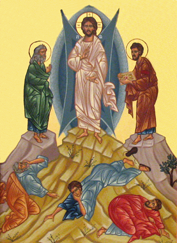August 6
After six days Jesus took Peter, James, and John his brother, and led them up a high mountain by themselves. And he was transfigured before them; his face shown like the sun and his clothes became white as light. And behold, Moses and Elijah appeared to them, conversing with him. Then Peter said to Jesus in reply, “Lord, it is good that we are here. If you wish, I will make three tents here, one for you, one for Moses, and one for Elijah.” While he was speaking, behold, a bright cloud cast a shadow over them, then from the cloud came a voice that said, “This is my beloved Son, with whom I am well pleased; listen to him.” When the disciples heard this, they fell prostrate and were very much afraid. But Jesus came and touched them, saying, “Rise, and do not be afraid.” And when the disciples raised their eyes, they saw no one else but Jesus alone. (Matthew 17:1-8)
The Transfiguration of our Lord celebrates the glorious change in appearance of our Lord Jesus Christ on Mount Tabor. The early Fathers referred to Christ’s transfiguration as his second epiphany or the second manifestation of His divinity.
Christian tradition since the fourth century has placed the site of the Transfiguration as the top of Mount Tabor, near Nazareth. There, St. Helen (approx. 250-330 AD) built the church of the Holy Transfiguration, solemnly dedicated on August 6.
In the Byzantine Rite the feast of the Holy Transfiguration has been traditionally celebrated on August 6 since at least the 8th century. In 1457 Pope Callistus III extended celebration of the feast to the entire Latin Rite Church. Thus the feast became a universal holy day, celebrated by both Eastern and Western churches on August 6.
In 680-681 the sixth Ecumenical Council in Constantinople prescribed that the “wheat and grapes” were to be blessed in church on the feast of the Holy Transfiguration. In accordance with Byzantine tradition, on this date fruits are blessed, originally apples, plums, and pears, but now especially grapes, because they are symbolic of the perpetually new transfiguration of our Lord in the Holy Eucharist and they act as a reminder of the transfiguration we must daily undergo as committed, baptized followers of Christ.
